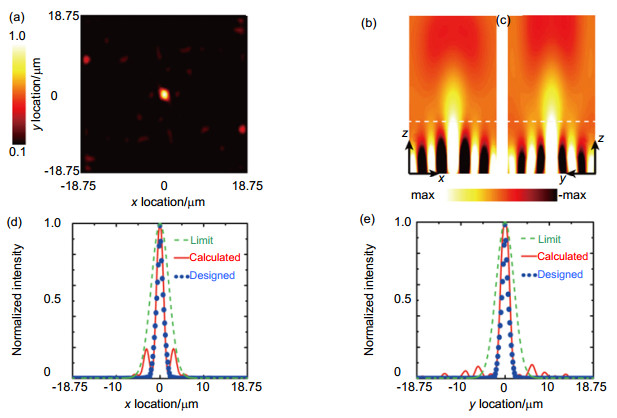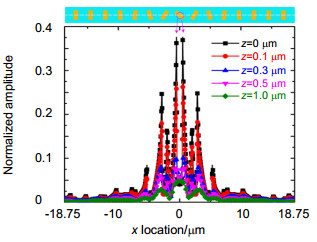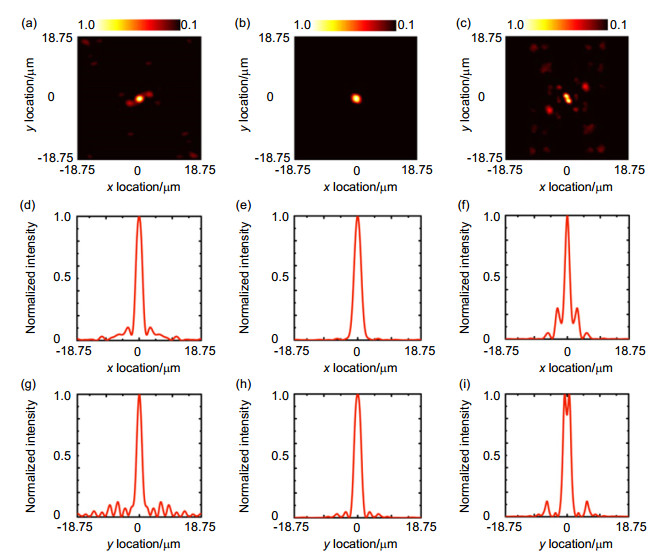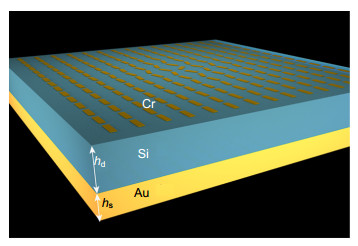Two dimensional subdiffraction focusing beyond the near-field diffraction limit via metasurface
-
Abstract:
Near-field plates with the capabilities of modulating the near-field pattern and forcing the incident wave to a subwavelength spot have been experimentally investigated at microwave wavelengths. Their superlensing properties result from the radiationless electromagnetic interference. However, the material's loss and limitations of state-of-the-art nanofabricating technology pose great challenges to scale down the microwave near-field plates to the infrared or optical region. In this paper, a related but alternative approach based on metasurface is introduced which breaks the near-field diffraction limit at mid-infrared region (10.6 μm). The metasurface consists of periodic arrangement of chromium dipolar antennas with the same geometry but spatially varying orientations, which plays the dual roles in achieving the prescribed amplitude modulation and the abrupt π phase change between the subwavelength neighboring elements. As a result, a two dimensional subdiffraction focus as small as 0.037λ2 at ~0.15λ above the metasurface is presented. In addition, the broadband response and ease fabrication bridge the gap between the theoretical investigation and valuable applications, such as near-field data storage, subdiffraction imaging and nanolithography.

-

Abstract:Subdiffraction focusing has enjoyed continued scientific interest, which leads to occurrence of the near-field plates with intriguing opportunity to set up a rapid oscillatory electromagnetic field that converges at a focus in the microwave band. However, abrupt π phase change and modulation of amplitude profile in the proximity of the surface have previously been seen as the main obstacles to scale such plates to visible or infrared regime, aggravated by loss and plasmonic feature comes into function. Severely, deep subwavelength spot is obtained at the price of decreasing the working distance, indeed, a near-field diffraction limit that could rarely go beyond in the nanofocusing system. In this paper, a radiationless electromagnetic interference (REI) approach based on metasurface is introduced which has not been reported to date. According to the back-propagation theory, a rapidly oscillatory electromagnetic field (simultaneously modulated amplitude and phase between subwavelength neighboring elements) in the proximity of NFP is necessary to force the incident wave to a subwavelength spot. The metasurface proposed here consists of periodic arrangement of chromium dipolar antennas with the same geometry but spatially varying orientations, which plays the dual roles in achieving the prescribed amplitude modulation and the abrupt π phase change. When a linearly polarized (LP) light illuminates the structure, partially scattered wave converts into the cross polarized light, the modulated amplitude is determined by the orientations of the dipolar antennas and the tuned phase is binary (0 and π), depending on the angle between the incident polarization and spatial orientations of the dipolar antennas. As a result, two dimensional subdiffraction focus as small as 0.037λ2 at ~0.15λ above the metasurface is presented which breaks the near-field diffraction limit at mid-infrared region (10.6 μm). The significance of the study lies in that our design of the metasurface based NFP combines a number of important advantages: precise amplitude and phase control, ease of fabrication, broadband subdiffraction focus at the same focal plane and three dimensional spot exceeding the near-field diffraction limit. This work is reminiscent of, but the physics inside is different from the previous REI methods. Different from the continuously various thicknesses of the metal film or refractive index of the insulator layer proposed before, the metasurface based NFP relaxes the problems of optimization and fabrication since the REI process (oscillatory modulations of amplitude and phase) is dependent on the rotation angle of the dipolar antenna. This design simplifies the manufacturing technology and bridges the gap between the theoretical investigation and valuable applications such as near-field data storage, subdiffraction imaging and nanolithography.
-

-
Figure S2. (a), (b) The numerically obtained y polarized field amplitude (Ey) distribution at the focal plane with the original parameters in Fig. S1 and the simplified binary phase. (c) The field profiles plotted along the horizontal line passing the spot center in (a) (red solid curve) and (b) (blue dot curve).
Figure 2. (a) Schematic of chromium dipolar antennas with length d, width w, and thickness h. All the antennas reside at the surface of silicon substrate. (b) Calculated transmitted amplitude (red square curve) and phase (green solid curve) of periodically arrayed building blocks versus the rotation angle θ between the orientation of antenna and the incident polarization Ei. Obviously, smooth amplitude variation has been achieved and a π phase jump occurs when the rotation angle exceeds 90°. (c) Schematic of the metasurface based NFP, which consists of periodic arrangement of chromium dipolar antennas with the same geometry but spatially varying orientations.
Figure 3. (a) Schematic of y-polarized electric field intensity (|Ey|2) distribution at focal plane. A two dimensional focus spot can be clearly seen as expected. (b) and (c) describe the cross-sectional plots of the transmitted y-polarized field (|Ey|) in the x-z plane, y-z plane, respectively, which show the process of radiationless electromagnetic interference. Alternative sign of the electric field indicates a π phase jump between the neighboring elements. The white dashed lines indicate the position of the focal plane. (d) and (e) show the calculated field profile (red solid curves) agrees well with the designed ones (blue circles), exceeding the near-field diffraction limit (green dashed curves). The discrepancies are originated from the relatively larger magnitude of the side lobes than the expected values.
Figure S4. (a) Calculated cross polarized field amplitude versus the rotation angle of the antenna. The maximum modulated field amplitude reaches 0.8 as normalized to the incident magnitude. (b) Schematic of y-polarized electric field intensity (|Ey|2) distribution at focal plane. (c) The red solid curve indicates the calculated y-polarized field intensity profile, which is narrower than the green dashed curve. It amounts to the focus quality exceeds the near-field diffraction limit as predicted.
-
[1] Betzig E, Trautman J K. Near-field optics: microscopy, spec-troscopy, and surface modification beyond the diffraction limit[J]. Science, 1992, 257(5067): 189-195. doi: 10.1126/science.257.5067.189
[2] Gramotnev D K, Bozhevolnyi S I. Plasmonics beyond the diffraction limit[J]. Nature Photonics, 2010, 4(2): 83-91. doi: 10.1038/nphoton.2009.282
[3] Gramotnev D K, Bozhevolnyi S I. Nanofocusing of electromagnetic radiation[J]. Nature Photonics, 2014, 8(1): 13-22. doi: 10.1038/nphoton.2013.232
[4] Shi Haofei, Guo L J. Design of plasmonic near field plate at optical frequency[J]. Applied Physics Letters, 2010, 96(14): 141107. doi: 10.1063/1.3378997
[5] Xu Ting, Agrawal A, Abashin M, et al. All-angle negative refraction and active flat lensing of ultraviolet light[J]. Nature, 2014, 497(7450): 470-474. http://cn.bing.com/academic/profile?id=182d1a924d97eae1fb44ee8111cb34cd&encoded=0&v=paper_preview&mkt=zh-cn
[6] Luo Xiangang, Pu Mingbo, Ma Xiaolinag, et al. Taming the electromagnetic boundaries via metasurfaces: from theory and fabrication to functional devices[J]. International Journal of Antennas and Propagation, 2015, 2015: 204127. http://cn.bing.com/academic/profile?id=6b5a1d46aa30085fe3b349962771be20&encoded=0&v=paper_preview&mkt=zh-cn
[7] Pendry J B. Negative refraction makes a perfect lens[J]. Physical Review Letters, 2000, 85(18): 3966-3969. doi: 10.1103/PhysRevLett.85.3966
[8] Gordon R. Limits for superfocusing with finite evanescent wave amplification[J]. Optics Letters, 2012, 37(5): 912-914. doi: 10.1364/OL.37.000912
[9] Fang N, Lee H, Sun Cheng, et al. Sub-diffraction-limited optical imaging with a silver superlens[J]. Science, 2005, 308(5721): 534-537. doi: 10.1126/science.1108759
[10] Song Maowen, Wang Changtao, Zhao Zeyu, et al. Nanofocusing beyond the near-field diffraction limit via plasmonic Fano resonance[J]. Nanoscale, 2016, 8(3): 1635-1641. doi: 10.1039/C5NR06504F
[11] Merlin R. Radiationless electromagnetic interference: evanes-cent-field lenses and perfect focusing[J]. Science, 2007, 317(5840): 927-929. doi: 10.1126/science.1143884
[12] Grbic A, Jiang Lei, Merlin R. Near-field plates: subdiffraction focusing with patterned surfaces[J]. Science, 2008, 320(5875): 511-513. doi: 10.1126/science.1154753
[13] Imani F M, Grbic A. Generating evanescent Bessel beams using near-field plates[J]. IEEE Transactions on Antennas and Propagation, 2012, 60(7): 3155-3164. doi: 10.1109/TAP.2012.2196947
[14] Grbic A, Merlin R. Near-field focusing plates and their design[J]. IEEE Transactions on Antennas and Propagation, 2008, 56(10): 3159-3165. doi: 10.1109/TAP.2008.929436
[15] Lan Lu, Jiang Wei, Ma Yungui. Three dimensional subwave-length focus by a near-field plate lens[J]. Applied Physics Letters, 2013, 102(23): 231119. doi: 10.1063/1.4810004
[16] Cai Wenshan, Shalaev V. Optical Metamaterials[M]. New York: Springer, 2010.
[17] Song Maowen, Yu Honglin, Hu Chenggang, et al. Conversion of broadband energy to narrowband emission through dou-ble-sided metamaterials[J]. Optics Express, 2013, 21(26): 32207-32216. doi: 10.1364/OE.21.032207
[18] Xu Ting, Wu Y K, Luo Xiangang, et al. Plasmonic nanoresonators for high-resolution colour filtering and spectral imaging[J]. Nature Communications, 2010, 1: 59. http://cn.bing.com/academic/profile?id=58b721149f760b10cc4ef8316eacff88&encoded=0&v=paper_preview&mkt=zh-cn
[19] Pu Mingbo, Hu Chenggang, Huang Cheng, et al. Investigation of Fano resonance in planar metamaterial with perturbed periodicity[J]. Optics Express, 2013, 21(1): 992-1001. doi: 10.1364/OE.21.000992
[20] Boltasseva A, Atwater H A. Low-loss plasmonic metamaterials[J]. Science, 2011, 331(6015): 290-291. doi: 10.1126/science.1198258
[21] Zeng Beibei, Gao Yongkang, Bartoli F J. Ultrathin nanostruc-tured metals for highly transmissive plasmonic subtractive color filters[J]. Scientific Reports, 2013, 3: 2840. doi: 10.1038/srep02840
[22] Gordon R. Proposal for superfocusing at visible wavelengths using radiationless interference of a plasmonic array[J]. Physics Review Letters, 2009, 102(20): 207402. doi: 10.1103/PhysRevLett.102.207402
[23] Chen Shuwen, Jin Shilong, Gordon R. Subdiffraction focusing enabled by a Fano resonance[J]. Physical Review X, 2014, 4(3): 031021. doi: 10.1103/PhysRevX.4.031021
[24] Yu Nanfang, Capasso F. Flat optics with designer metasurfaces[J]. Nature Materials, 2014, 13(2): 139-150. doi: 10.1038/nmat3839
[25] Ni Xingjie, Emani N K, Kildishev A V, et al. Broadband light bending with plasmonic nanoantennas[J]. Science, 2012, 335(6067): 427. doi: 10.1126/science.1214686
[26] Kildishev A V, Boltasseva A, Shalaev V M. Planar photonics with metasurfaces[J]. Science, 2013, 339(6125): 1232009. doi: 10.1126/science.1232009
[27] Liu Lixiang, Zhang Xueqian, Kenney M, et al. Broadband metasurfaces with simultaneous control of phase and ampli-tude[J]. Advanced Materials, 2014, 26(29): 5031-5036. doi: 10.1002/adma.201401484
[28] Li Xiong, Chen Lianwei, Li Yang, et al. Multicolor 3D me-ta-holography by broadband plasmonic modulation[J]. Science Advance, 2016, 2(11): e1601102.
[29] Jin Jinjin, Pu Mingbo, Wang Yanqin, et al. Multi-channel vortex beam generation by simultaneous amplitude and phase modulation with two-dimensional metamaterial[J]. Advanced Materials Technologies, 2017, 2(2): 1600201. doi: 10.1002/admt.201600201
[30] Cui Jianhua, Huang Cheng, Pan Wenbo, et al. Dynamical manipulation of electromagnetic polarization using anisotropic meta-mirror[J]. Scientific Reports, 2016, 6: 30771. doi: 10.1038/srep30771
[31] Liu Kaipeng, Guo Yinghui, Pu Mingbo, et al. Wide field-of-view and broadband terahertz beam steering based on gap plasmon geodesic antennas[J]. Scientific Reports, 2017, 7: 41642. doi: 10.1038/srep41642
[32] Ma Xiaoliang, Pu Mingbo, Li Xiong, et al. Optical phased array radiating optical vortex with manipulated topological charges[J]. Optics Express, 2015, 23(4): 4873-4879. doi: 10.1364/OE.23.004873
[33] Pu Mingbo, Li Xiong, Ma Xiaoliang, et al. Catenary optics for achromatic generation of perfect optical angular momentum[J]. Science Advances, 2015, 1(9): e1500396. doi: 10.1126/sciadv.1500396
[34] Khorasaninejad M, Chen Weiting, Devlin R C, et al. Metalenses at visible wavelengths: diffraction-limited focusing and sub-wavelength resolution imaging[J]. Science, 2016, 352(6290): 1190-1194. doi: 10.1126/science.aaf6644
[35] Ni Xingjie, Ishii S, Kildishev A V, et al. Ultra-thin, planar, Babi-net-inverted plasmonic metalenses[J]. Light: Science & Applications, 2013, 2(4): e27.
[36] Chen Xianzhong, Huang Lingling, Mühlenbernd H, et al. Dual-polarity plasmonic metalens for visible light[J]. Nature Communications, 2012, 3: 1198. doi: 10.1038/ncomms2207
[37] Huang Lingling, Chen Xianzhong, Mühlenbernd H, et al. Dispersionless phase discontinuities for controlling light propagation[J]. Nano Letters, 2012, 12(11): 5750-5755. doi: 10.1021/nl303031j
[38] Tang Dongliang, Wang Changtao, Zhao Zeyu, et al. Ul-trabroadband superoscillatory lens composed by plasmonic metasurfaces for subdiffraction light focusing[J]. Laser & Pho-tonics Review, 2015, 9(6): 713-719. https://www.researchgate.net/publication/282844946_Ultrabroadband_superoscillatory_lens_composed_by_plasmonic_metasurfaces_for_subdiffraction_light_focusing
[39] Palik E D. Handbook of Optical Constants of Solids[M]. New York: Academic, 1985.
[40] Pors A, Nielsen M G, Eriksen R L, et al. Broadband focusing flat mirrors based on plasmonic gradient metasurfaces[J]. Nano Letters, 2013, 13(2): 829-834. doi: 10.1021/nl304761m
[41] Alonso-Gonzalez P, Schnell M, Sarriugarte P, et al. Real-space mapping of fano interference in plasmonic metamolecules[J]. Nano Letters, 2011, 11(9): 3922-3926. doi: 10.1021/nl2021366
-


 E-mail Alert
E-mail Alert RSS
RSS
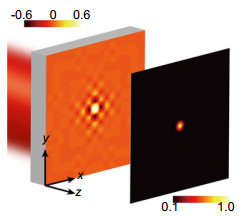
 下载:
下载:



